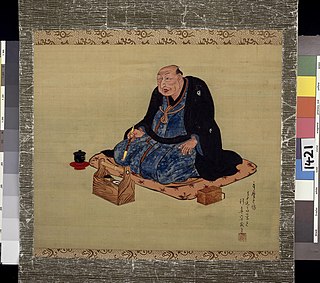Related Research Articles

Kitagawa Utamaro was a Japanese artist. He is one of the most highly regarded designers of ukiyo-e woodblock prints and paintings, and is best known for his bijin ōkubi-e "large-headed pictures of beautiful women" of the 1790s. He also produced nature studies, particularly illustrated books of insects.

Ukiyo-e is a genre of Japanese art which flourished from the 17th through 19th centuries. Its artists produced woodblock prints and paintings of such subjects as female beauties; kabuki actors and sumo wrestlers; scenes from history and folk tales; travel scenes and landscapes; flora and fauna; and erotica. The term 'ukiyo-e' translates as "picture[s] of the floating world".

Katsushika Hokusai, known simply as Hokusai, was a Japanese artist, ukiyo-e painter and printmaker of the Edo period. Hokusai is best known for the woodblock print series Thirty-Six Views of Mount Fuji which includes the internationally iconic print The Great Wave off Kanagawa.

Utagawa Kunisada, also known as Utagawa Toyokuni III, was the most popular, prolific and commercially successful designer of ukiyo-e woodblock prints in 19th-century Japan. In his own time, his reputation far exceeded that of his contemporaries, Hokusai, Hiroshige and Kuniyoshi.

The Dream of the Fisherman's Wife, also known as Girl Diver and Octopi, Diver and Two Octopi, etc., is a woodblock-printed design by the Japanese artist Hokusai. It is included in Kinoe no Komatsu, a three-volume book of shunga erotica first published in 1814, and has become Hokusai's most famous shunga design. Playing with themes popular in Japanese art, it depicts a young ama diver entwined sexually with a pair of octopuses.

Shunga (春画) is a type of Japanese erotic art typically executed as a kind of ukiyo-e, often in woodblock print format. While rare, there are also extant erotic painted handscrolls which predate ukiyo-e. Translated literally, the Japanese word shunga means picture of spring; "spring" is a common euphemism for sex.

Utagawa Hiroshige, born Andō Hiroshige, was a Japanese ukiyo-e artist, considered the last great master of that tradition.

Torii Kiyonaga was a Japanese ukiyo-e artist of the Torii school. Originally Sekiguchi Shinsuke, the son of an Edo bookseller, from Motozaimokuchō Itchōme in Edo, he took on Torii Kiyonaga as an art name. Although not biologically related to the Torii family, he became head of the group after the death of his adoptive father and teacher Torii Kiyomitsu.

Woodblock printing in Japan is a technique best known for its use in the ukiyo-e artistic genre of single sheets, but it was also used for printing books in the same period. Widely adopted in Japan during the Edo period (1603–1868) and similar to woodcut in Western printmaking in some regards, the mokuhanga technique differs in that it uses water-based inks—as opposed to western woodcut, which typically uses oil-based inks. The Japanese water-based inks provide a wide range of vivid colors, glazes, and transparency.

Toyohara Chikanobu, better known to his contemporaries as Yōshū Chikanobu (楊洲周延), was a prolific woodblock artist of Japan's Meiji (era).

Tsutaya Jūzaburō was the founder and head of the Tsutaya publishing house in Edo, Japan, and produced illustrated books and ukiyo-e woodblock prints of many of the period's most famous artists. Tsutaya's is the best-remembered name of all ukiyo-e publishers. He is also known as Tsuta-Jū and Jūzaburō I.
Ogata Gekkō was a Japanese artist best known as a painter and a designer of ukiyo-e woodblock prints. He was self-taught in art, and won numerous national and international prizes and was one of the earliest Japanese artists to win an international audience.

Kobayashi Kiyochika was a Japanese ukiyo-e artist, best known for his colour woodblock prints and newspaper illustrations. His work documents the rapid modernization and Westernization Japan underwent during the Meiji period (1868–1912) and employs a sense of light and shade called kōsen-ga inspired by Western art techniques. His work first found an audience in the 1870s with prints of red-brick buildings and trains that had proliferated after the Meiji Restoration; his prints of the First Sino-Japanese War of 1894–95 were also popular. Woodblock printing fell out of favour during this period, and many collectors consider Kobayashi's work the last significant example of ukiyo-e.
Richard Douglas Lane (1926–2002) was an American scholar, author, collector, and dealer of Japanese art. He lived in Japan for much of his life, and had a long association with the Honolulu Museum of Art in Hawaii, which now holds his vast art collection.

Kōno Bairei was a Japanese painter, book illustrator, and art teacher. He was born and lived in Kyoto. He was a member of the Ukiyo-e school and was a master of kacho-e painting in the Meiji period of Japan.

E-hon or Ehon (絵本) is the Japanese term for picture books. It may be applied in the general sense, or may refer specifically to a type of woodblock printed illustrated volume published in the Edo period.

Zashiki Hakkei is a series of eight prints from 1766 by the Japanese ukiyo-e artist Suzuki Harunobu. They were the first full-colour nishiki-e prints and are considered representative examples of Harunobu's work. The prints are mitate-e parodies of popular themes of the 11th-century Chinese landscape painting series, Eight Views of Xiaoxiang; Harunobu replaces natural scenery with domestic scenes.

Utamakura is the title of a 12-print illustrated book of sexually explicit shunga pictures, published in 1788. The print designs are attributed to the Japanese ukiyo-e artist Kitagawa Utamaro, and the book's publication to Tsutaya Jūzaburō.

Yamaguchi Soken, also called Takejirō was a Japanese painter of the Shijō school. He was one of the "Ten Great Ones", taught by Maruyama Ōkyo.
References
- ↑ Dr Ellis Tinios. University of Leeds. Retrieved 17 December 2017.
- ↑ "Ellis Tinios - Rare Book School". Rarebookschool.org. Retrieved 18 December 2017.
- ↑ "Term details". British Museum. Retrieved 18 December 2017.